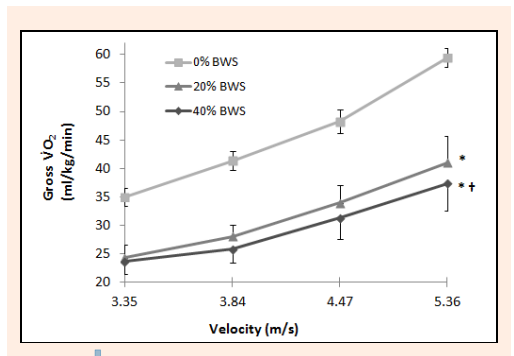Key words: anti-gravity treadmill, distance running, elite, oxygen consumption, LBPP treadmil
In recent years, anti-gravity treadmills that provide partial body weight support (BWS) have become increasingly common among elite athletes as a supplementary training and rehabilitation tool. There are currently several technologies that enable BWS on anti-gravity treadmills, including harness systems, underwater treadmills, and the latest development of lower body positive pressure (LBPP) applications. These LBPP treadmills, known as “anti-gravity treadmills,” support the user’s weight by applying positive air pressure in a sealed chamber around the subject’s pelvis and legs. These LBPP treadmills reduce the ground reaction forces (GRF) associated with running while maintaining cardiovascular training by increasing the speed of the microgravity treadmill.
The purpose of this study was to add data on elite runners to the growing literature on LBPP treadmills. Specifically, the aim was to determine the relationship between speed and metabolic cost when running on an LBPP treadmill and to study how the application of BWS affects this relationship.
Article cited in:©Journal of Sports Science and Medicine (2015) 14, 333-339
Article link:Oxygen Consumption of Elite Distance Runners on an Anti-Gravity Treadmill
Previous studies of oxygen consumption in non-elite runners have shown that oxygen consumption decreases when BWS is increased using anLBPP treadmill.
Furthermore, the percentage reduction in oxygen consumption was inversely related to the amount of BWS provided in conditions with relatively little support, but directly proportional to the percentage of BWS provided in conditions with more support.
For example, Grabowski and Kram (2008) reported that applying approximately 25%, 50%, and 75% of BWS to reduce metabolic capacity at a speed of 3 m/s yielded data of 25%, 36%, and 45%, respectively. The data obtained by reducing the metabolic capacity at a speed of 4m/s are 31%, 43% and 53% respectively. Studies have also shown deviations in the actual amount of BWS provided by LBPP treadmill equipment compared to mechanically calibrated support levels.

Experimental comparison:Heart rate was monitored throughout each test using a heart rate monitor. Participants’ rating of perceived exertion (RPE) was determined using the original Borg scale (Borg, 1970) at the end of every two minutes. VO2 and VCO2 were measured continuously throughout each test, and the average VO2 data during the last minute of each four-minute stage was recorded. To ensure the measured VO2 best accounted for the energy cost of running at each of the> four veloc>>ities, VO2 data was only included when the measured Respiratory Exchange Ratio (RER) did not exceed 1.00, indicating a predominantly aerobic effort. Individual regression equations were considered for each of the subjects who had VO2 measurements associated with an RER 1.00. If, in those subjects, there was a visually obvious plateau in Δ VO2/Δv at those velocities with an RER 1.00, or if the slope of the equation was greatly reduced when the measurement associated with an RER 1.00 was included, then the VO2 measured at that velocity was excluded from the analysis.
While running at 5.36 m∙s -1 on the regular treadmill, one participant demonstrated an RER 1.00 (1.03) without any obvious departure of the measured VO2 at that velocity from the slope of their regression equation, so this value was still included in the analysis. For one participant, improper positioning of the mouthpiece during the test at 40% BWS yielded inaccurate measurements for the first three velocities (3.35, 3.84, and 4.47 m∙s -1 ) before being fixed, so these measurements were not included in the analysis.>
Graph depicting the relationship between gross VO2 and velocity at each of the three levels of BWS:

Discussion of results:Explanations for the present study’s findings can be found in several previous studies that examined the effects of BWS on the metabolic costs of running. The application of LBPP has a clear role in reducing the costs associated with vertical support of body weight during running gait. But as Grabowski and Crumb (2008) demonstrated, LBPP also plays a role in providing forward horizontal assistance, thus reducing the attendant costs of forward propulsion during running gait.
In the present study, 20% BWS may constitute the optimal level of applied horizontal support, while the further small reduction in metabolic demand at 40% BWS may be mainly due to the reduced cost of vertically supporting body weight. Evidence from Grabowski and Crumb (2008) that horizontal assist force increases with speed may also explain the ease of acceleration of BWS found in this study.